Cross country skiing is the oldest form of skiing and indeed the word ‘ski’ comes from the Old Norse word ‘skid’ which means a split length of wood.
In days gone by the only means by which folk from the far North were able to move over snow-covered terrain to hunt and visit other communities was by strapping two planks of wood to their feet.
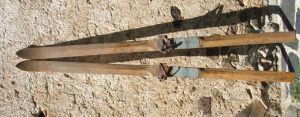
Although cross country skiing was initially a necessity, it eventually developed into a sport in the late 19th century. Today it is an Olympic sport which is not surprisingly dominated by the Scandinavian countries who have XC skiing in their blood.
XC skiing centres
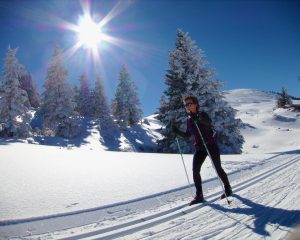
Cross country skiing is gaining in popularity as a leisure activity in mountainous regions all over the world.
In the Pyrenees, there are several dedicated centres at which both the classic and skating styles of cross country skiing are catered for.
The classic style is usually adopted by people new to the sport as it involves sking in ready made ski-wide pisted tracks.
You can ski at your own pace with no pressure and simply enjoy the feeling of movement in the snow.
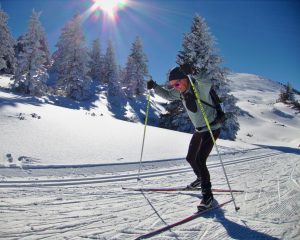
The skating style however is done on packed-smooth pisted snow and can be an intense cardio workout, often used by professional sports people as cross training.
It is a completely different action to the classic style and requires both upper and lower body fitness and coordination.
So why should you consider trying cross country skiing rather than sticking to the downhill slopes on your winter holiday?
Cross country skiing is easy to pick up
It has been said that if you can walk you can cross country ski.
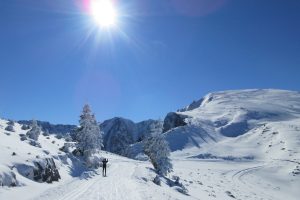
Using the classic style and with skinny skis attached to your flexible boots, you propel yourself along the tracks using an arm and leg action.
It should be a rhythmic motion which with practice becomes quite a mesmerising glide.
Once you get into the flow you can completely lose yourself in the motion and cover quite some distance.
But if it’s your first time cross country skiing be aware that you will be using muscles you probably didn’t know you had!
So take it steady on your first outing and concentrate on technique rather than distance.
Cross country ski tracks are graded
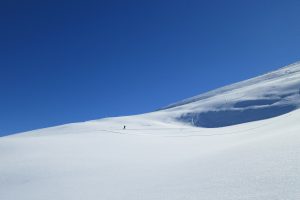
As with downhill resort skiing, the cross country skiing circuits are all graded from green to black.
They will vary in length and technical difficulty with the harder circuits being longer and with sections that demand certain techniques which have to be learnt.
Cross country skiing is a family friendly sport and much easier for children to pick up than downhill skiing.
Lessons are always available at the centres should you want to make sure you’re starting off with the correct technique.
Learning how to snowplough to a halt is one of the most valuable lessons you can learn as the circuits are never perfectly flat.
Cheaper than DH skiing
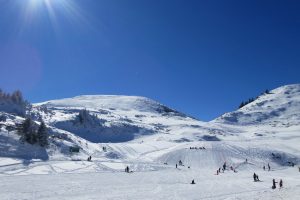
There are no mechanical uplifts at the cross country ski resorts and consequently no need for the manpower that operates them.
The only equipment essential to the running of the station is the track-maker/small piste basher which makes for low overheads which is reflected in lower pass fees.
The hire cost for cross country ski equipment is a fraction of that for downhill skiing, but the biggest saving of all is in the clothes you need to wear.
Whereas resort skiing requires you to kit the family out in ski jackets and salopettes, nothing of the sort is needed for XC skiing.
Indeed, the biggest mistake you can make is to wear heavy downhill ski gear!
A pair of leggings, warm socks, lightweight layers for the upper body (we can’t recommend merino enough) plus light but warm gloves and possibly a hat are all that you need if you are skiing on a blue sky day. Anything more and you will very quickly be shedding layers as you overheat.
Benefits for sports people
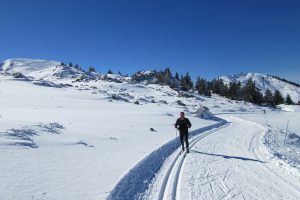
If you are a sports person in another discipline, XC skiing is quite simply one of the best off season cross training disciplines out there.
It’s a great way to maintain cardio-vascular benefits and also uses just about every muscle in the body.
It can improve a runner’s balance as well as strengthen the ankles and make them more flexible.
With the classic style of cross country skiing, you’ll soon discover muscular imbalances as you strive to keep your skis in the tracks.
The muscles of the pelvic girdle as well as the small abductor muscles will all be strengthened through cross country skiing.
Conclusion
Cross country skiing is a cost-effective winter sport that is open to all. But beware, once you’ve tried it you’ll be hooked.
As you progress you’ll realise just what strength and endurance, balance and agility are required to be a good XC skier.
It’s a sport that both builds and demands good physical fitness. If you’ve never tried it, give it a go. You won’t regret it.
Sharing is caring. If you’ve enjoyed this blog post, feel free to share the following image;
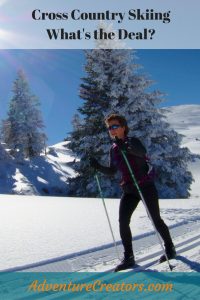


Comments